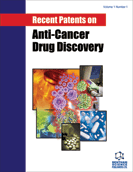
Abstract
Background: Many laboratories have made intensive efforts to develop potent, selective, and orally bioavailable HDAC inhibitors (HDACIs). Novel HDACIs are being developed with the objective of improving potency and selectivity against specific types of cancers or non-cancer diseases.
Objective: This updated patent review is an attempt to compile the work of various researchers of HDACIs from 2012 to mid 2016, and to enlighten and surprise both newcomers in this field and devoted medicinal chemists. Method: According to the literature research and the writers' own research experience in the discovery of HDAC inhibitors. Results: The inhibitors possessing new chemical scaffolds have attracted immense interest because they have the ability to improve HDAC isoform specificity and pharmaceutical properties. Focus is given to emerging medicinal chemistry principles and insights into the discovery and development of HDAC inhibitors. Conclusion: The development of effective HDACIs is shifting from trial-and-error approaches to sophisticated strategies. Effective profiling technologies will continue to have important utility.Keywords: Chelating, drug design, epigenetics, HDAC inhibitor, histone acetylation, metalloprotein, patent, synthesis.
Recent Patents on Anti-Cancer Drug Discovery
Title:Medicinal Chemistry Insights into Novel HDAC Inhibitors: An Updated Patent Review (2012-2016)
Volume: 12 Issue: 1
Author(s): Peng Zhan, Xueshun Wang, Xinyong Liu and Takayoshi Suzuki
Affiliation:
Keywords: Chelating, drug design, epigenetics, HDAC inhibitor, histone acetylation, metalloprotein, patent, synthesis.
Abstract: Background: Many laboratories have made intensive efforts to develop potent, selective, and orally bioavailable HDAC inhibitors (HDACIs). Novel HDACIs are being developed with the objective of improving potency and selectivity against specific types of cancers or non-cancer diseases.
Objective: This updated patent review is an attempt to compile the work of various researchers of HDACIs from 2012 to mid 2016, and to enlighten and surprise both newcomers in this field and devoted medicinal chemists. Method: According to the literature research and the writers' own research experience in the discovery of HDAC inhibitors. Results: The inhibitors possessing new chemical scaffolds have attracted immense interest because they have the ability to improve HDAC isoform specificity and pharmaceutical properties. Focus is given to emerging medicinal chemistry principles and insights into the discovery and development of HDAC inhibitors. Conclusion: The development of effective HDACIs is shifting from trial-and-error approaches to sophisticated strategies. Effective profiling technologies will continue to have important utility.Export Options
About this article
Cite this article as:
Zhan Peng, Wang Xueshun, Liu Xinyong and Suzuki Takayoshi, Medicinal Chemistry Insights into Novel HDAC Inhibitors: An Updated Patent Review (2012-2016), Recent Patents on Anti-Cancer Drug Discovery 2017; 12 (1) . https://dx.doi.org/10.2174/1574892811666161101102842
| DOI https://dx.doi.org/10.2174/1574892811666161101102842 |
Print ISSN 1574-8928 |
| Publisher Name Bentham Science Publisher |
Online ISSN 2212-3970 |
 108
108 4
4 1
1
- Author Guidelines
- Graphical Abstracts
- Fabricating and Stating False Information
- Research Misconduct
- Post Publication Discussions and Corrections
- Publishing Ethics and Rectitude
- Increase Visibility of Your Article
- Archiving Policies
- Peer Review Workflow
- Order Your Article Before Print
- Promote Your Article
- Manuscript Transfer Facility
- Editorial Policies
- Allegations from Whistleblowers
Related Articles
-
Emerging Indications for Statins: A Pluripotent Family of Agents with Several Potential Applications
Current Pharmaceutical Design New Approaches to the Modulation of the Cyclooxygenase-2 and 5-Lipoxygenase Pathways
Current Topics in Medicinal Chemistry The Woman’s Heart: Insights into New Potential Targeted Therapy
Current Medicinal Chemistry Cardioprotective Effects of Indian Gooseberry (Emblica officinalis Gaertn) and its Phytochemicals: A Review
Current Nutrition & Food Science Pexelizumab and its Role in the Treatment of Myocardial Infarction and in Coronary Artery Bypass Graft Surgery: A Review
Recent Patents on Cardiovascular Drug Discovery Soluble Epoxide Hydrolase Inhibitors and their Potential for Treatment of Multiple Pathologic Conditions
Current Medicinal Chemistry Novel Targets of Metformin in Cardioprotection: Beyond the Effects Mediated by AMPK
Current Pharmaceutical Design Hemodynamic Regulation of Metallopeptidases within the Vasculature
Protein & Peptide Letters Leptin Induces Neuroprotection Neurogenesis and Angiogenesis after Stroke
Current Neurovascular Research Small Artery Remodeling in Obesity and Insulin Resistance
Current Vascular Pharmacology Subject Index to Volume 4
Current Drug Targets - Cardiovascular & Hematological Disorders Molecular Imaging of Vascular Inflammation
Current Pharmaceutical Design Lipid Raft in Cardiac Health and Disease
Current Cardiology Reviews Stent Thrombosis and Duration of Dual Antiplatelet Therapy
Current Pharmaceutical Design Curcumin Efficacy in a Serum/Glucose Deprivation-Induced Neuronal PC12 Injury Model
Current Molecular Pharmacology Diallyl Sulfide: Potential Use in Novel Therapeutic Interventions in Alcohol, Drugs, and Disease Mediated Cellular Toxicity by Targeting Cytochrome P450 2E1
Current Drug Metabolism Genetic Variations of the Hemostatic System as Risk Factors for Venous and Arterial Thrombotic Disease
Current Genomics Sutureless Aortic Valve Replacement Using Perceval S Valve
Recent Patents on Cardiovascular Drug Discovery Biological Importance, Therapeutic Benefit and Analytical Aspects of Bioactive Flavonoid Pectolinarin in the Nature
Drug Metabolism Letters Roles of p38-MAPK in Insulin Resistant Heart: Evidence from Bench to Future Bedside Application
Current Pharmaceutical Design


























